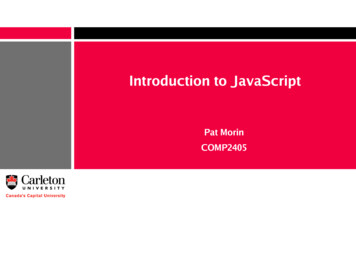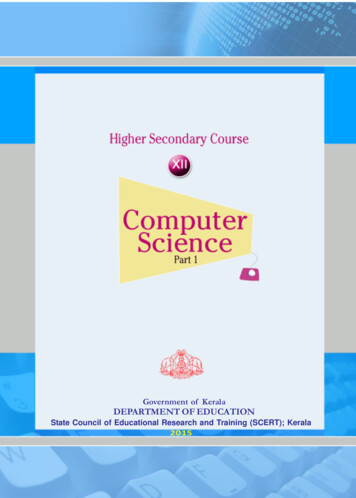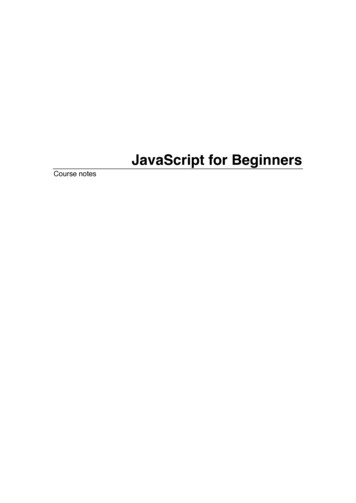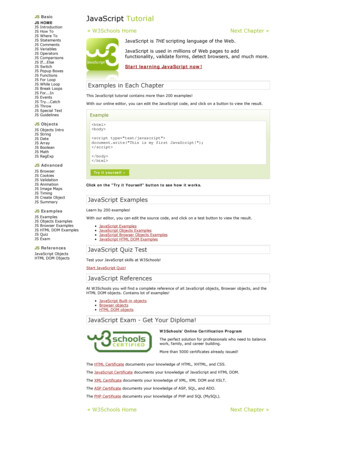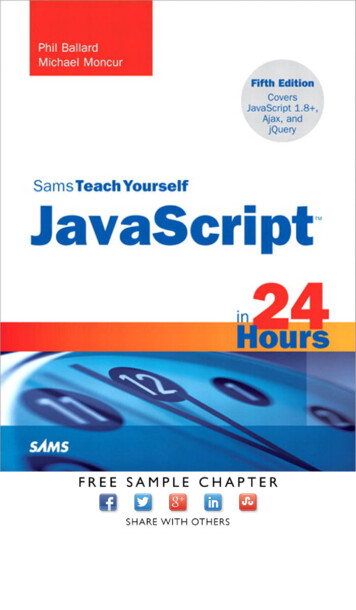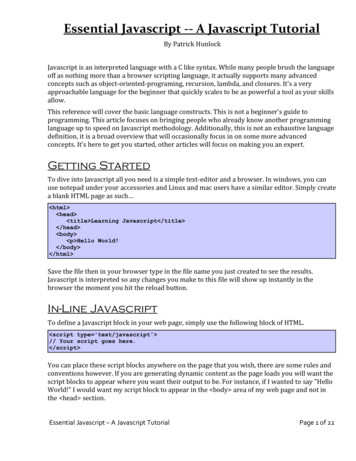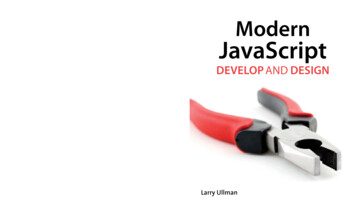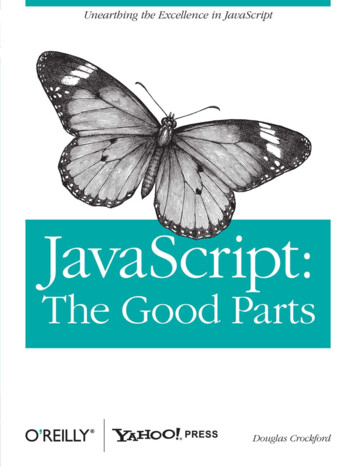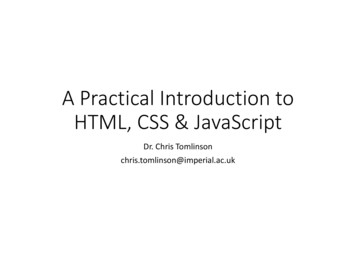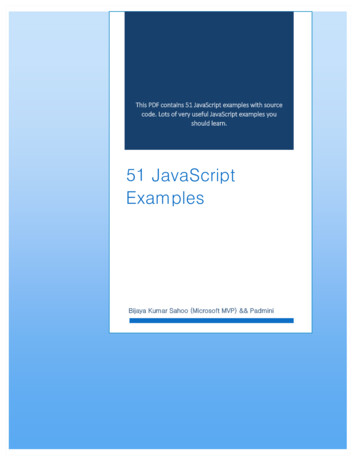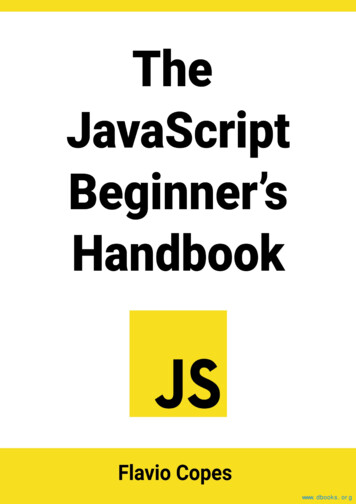
Transcription
Extracted from:Rediscovering JavaScriptMaster ES6, ES7, and ES8This PDF file contains pages extracted from Rediscovering JavaScript, publishedby the Pragmatic Bookshelf. For more information or to purchase a paperback orPDF copy, please visit http://www.pragprog.com.Note: This extract contains some colored text (particularly in code listing). Thisis available only in online versions of the books. The printed versions are blackand white. Pagination might vary between the online and printed versions; thecontent is otherwise identical.Copyright 2018 The Pragmatic Programmers, LLC.All rights reserved.No part of this publication may be reproduced, stored in a retrieval system, or transmitted,in any form, or by any means, electronic, mechanical, photocopying, recording, or otherwise,without the prior consent of the publisher.The Pragmatic BookshelfRaleigh, North Carolina
Rediscovering JavaScriptMaster ES6, ES7, and ES8Venkat SubramaniamThe Pragmatic BookshelfRaleigh, North Carolina
Many of the designations used by manufacturers and sellers to distinguish their productsare claimed as trademarks. Where those designations appear in this book, and The PragmaticProgrammers, LLC was aware of a trademark claim, the designations have been printed ininitial capital letters or in all capitals. The Pragmatic Starter Kit, The Pragmatic Programmer,Pragmatic Programming, Pragmatic Bookshelf, PragProg and the linking g device are trademarks of The Pragmatic Programmers, LLC.Every precaution was taken in the preparation of this book. However, the publisher assumesno responsibility for errors or omissions, or for damages that may result from the use ofinformation (including program listings) contained herein.Our Pragmatic books, screencasts, and audio books can help you and your team createbetter software and have more fun. Visit us at https://pragprog.com.The team that produced this book includes:Publisher: Andy HuntVP of Operations: Janet FurlowManaging Editor: Brian MacDonaldSupervising Editor: Jacquelyn CarterCopy Editor: Liz WelchIndexing: Potomac Indexing, LLCLayout: Gilson GraphicsFor sales, volume licensing, and support, please contact support@pragprog.com.For international rights, please contact rights@pragprog.com.Copyright 2018 The Pragmatic Programmers, LLC.All rights reserved.No part of this publication may be reproduced, stored in a retrieval system, or transmitted,in any form, or by any means, electronic, mechanical, photocopying, recording, or otherwise,without the prior consent of the publisher.Printed in the United States of America.ISBN-13: 978-1-68050-546-7Encoded using the finest acid-free high-entropy binary digits.Book version: P1.0—June 2018
IntroductionA few days before a corporate event, the company informed me that thedevelopers attending would be a mixture of Java, C#, and PHP programmers.I was concerned that presenting examples in Java may frustrate C# and PHPprogrammers. Picking any of the other two languages might have similarconsequences. I made an executive decision and used JavaScript for all myexamples—that way, I frustrated them all equally. Just kidding. It turned outto be a good choice—JavaScript is truly one language used by programmerswho otherwise use different languages for most of their work.JavaScript is the English of the programming world—it’s native to some people,it’s arguably the most widely used language, and the language itself hasheavily borrowed from other languages, for greater good.JavaScript is one of the most powerful, ubiquitous, and flexible languages. Alarge number of programmers fear the language for many reasons. In the pastit had become infamous for being error prone and idiosyncratic. Thankfully,through the newer versions, JavaScript has evolved into a respectable language;it has come a long way since Douglas Crockford wrote JavaScript: The GoodParts [Cro08].Unlike other languages, JavaScript does not have the luxury to deprecatefeatures. Such a measure would be considered draconian—currently workinglegacy code will suddenly fail on newer browsers. The language had to evolvewithout breaking backward compatibility.The changes in JavaScript comes in three flavors: alternatives, additions, andadvances.Features that are error prone and outright confusing have alternative featuresin the newer versions. For example, const and let are the new alternatives tothe messy var declarations. The rest operator, which makes it easier to createself-documenting code, is a much better alternative to arguments, which lacksclarity and needs explicit documentation. Also, the enhanced for loop removesthe burden of looping that is inherent in the traditional for loops. While the Click HERE to purchase this book now. discuss
Introduction viold way of doing things still exists, we should make a conscious effort to learnand use the newer alternatives.When coming from other languages, programmers often say, “I wish JavaScripthad ” A lot of those wishes have come true. JavaScript has adapted featuresfound in languages like Java, C#, and Ruby, to mention a few. These additionsto the language not only make the language more pleasant to use but alsohelp solve a set of problems in a more elegant way than before.In the vein of comparing with other languages, generators and infinite iteratorsin JavaScript make it possible to create lazy sequences as in languages likeHaskell or Clojure. Arrow functions bring the power of lambda expressionswith consistent lexical scoping while making the code concise and expressive.Template literals bring the feature of heredocs from languages like Ruby andGroovy to JavaScript. And the enhanced class syntax makes programming inJavaScript feel almost like any other object-oriented language well, almost.And what good is a language that does not allow you to create programs thatcan in turn create programs? JavaScript makes it easy to turn those metathoughts into useful programs using the advances in the area of metaprogramming. The Proxy class, along with many capabilities of the language to createdynamic, flexible, and asynchronous code, makes JavaScript a very excitinglanguage to program in. If you have enjoyed metaprogramming in languageslike Ruby, Python, and Groovy, JavaScript now has similar capabilities tocreate highly flexible and extensible code.The changes in recent years bring an entirely different feeling and vibe to thelanguage. It is a great time to be excited about programming in JavaScript.Whether you are programming the front end or writing code for the serverside back end, you can use the newer language features to make your codeelegant, concise, expressive, and above all less error prone.There is no better way to learn the language than practicing. This book hasseveral examples for you to try out, as you learn about the new and excitingfeatures.Fire up your favorite IDE or text editor—let’s get coding.How to Run Modern JavaScriptJavaScript has evolved considerably but the runtime engines are still catchingup. Different browsers have varied support for different features from thenewer versions of JavaScript. Click HERE to purchase this book now. discuss
How to Run Modern JavaScript viiSites like kangax.github.io1 and caniuse.com2 can help you find whether aparticular browser supports a JavaScript feature you’re interested in using.MDN3 web docs is a good source for documentation of JavaScript features andsupport in a few different browsers. The good news is all browsers will be 100percent features compatible within the next 20 years—or so it feels—but wecan’t wait that long.If you are developing for the back end using JavaScript, you may have bettercontrol of the version of the runtime engine you use. If you are developing forthe front end, you may not have much say about the browser and the versionof browser your users have. The version they use may not support a particularfeature, or it may be an old browser and may not support any of the featuresof modern JavaScript. What gives?Here are a few options to run JavaScript in general and, in particular, topractice the examples and exercises in this book.Run in Node.jsThe easiest way to practice the code examples in this book is running themin Node.js.4 Version 8.5 or later supports most of the latest features. I willguide you along where necessary if you need to use a command-line experimental option or an additional tool.First, verify that Node.js is installed on your system. Point your browser tohttps://nodejs.org and download the latest version if you don’t have it or have afairly old version. To avoid colliding with versions of Node.js already installedon your system, use Node Version Manager5 (NVM) if it’s supported on youroperating system.Once you install the latest version of Node.js, open a command prompt and typenode --versionThe version of Node.js used to run the examples in this book isv9.5.0The version installed on your machine may be different. If it’s very old compared to the version mentioned here, consider installing a more recent ionix/nvm Click HERE to purchase this book now. discuss
Introduction viiiIf what you have is later than the version shown here, then continue usingthe version you have.To run the program in Node.js, issue the node command followed by the filename. For example, suppose we have a file named hello.js with the 'Hello Modern JavaScript');Use the following command at the command prompt to run the code:node hello.jsThe command will produce the desired output:Hello Modern JavaScriptMost IDEs that support JavaScript offer ways to more easily run the code fromwithin the IDE. Make sure that your IDE is configured to use an appropriateversion of Node.js.Run Using the REPLEven though I use text editors and IDEs to develop applications, I am a hugefan of REPL, which stands for “read-eval-print-loop.” I call it the micro-prototyping environment. While in the middle of working on a function or implementing enough code to make a unit test to pass, I often reach for the REPLto quickly try out ideas. This is like how painters prime their brushes on theside of the canvas while painting.Let’s fire up the REPL and try out a snippet of code. The Node.js commandnode, when executed without any filename, runs in the REPL mode.At the command prompt type the command node and press Enter. In the nodeprompt, which appears as , type various JavaScript code snippets and pressEnter to run immediately. The output from the execution of the snippet isshown instantly. To exit from the REPL, press Ctrl C twice, press Ctrl D, ortype .exit.Let’s take the REPL for a ride. Here’s an interactive session for you to try:node languages ['Java', 'Python', 'Ruby', 'JavaScript'][ 'Java', 'Python', 'Ruby', 'JavaScript' ] word 'Hello''Hello' word.st(hit tab)word.startsWith word.strike Click HERE to purchase this book now. discuss
How to Run Modern JavaScript ix word.startsWith('H')true languages.filter(language language.startsWith('J'))[ 'Java', 'JavaScript' ] In the REPL, create a list of languages and the REPL immediately evaluatesand prints the list. Now, suppose we want to pick only languages that startwith J. Hmm, does string support a startsWith() function? Why guess? We canask the REPL.Create a variable named word and set it to the string 'Hello'. Then type word.st andpress the Tab key. The REPL lists all methods of string that start with st. Thenit repeats the command you had already typed. Type a after word.st and pressthe Tab key again. The REPL now will complete the code with word.startsWith.Proceed to complete that call and press Enter.Finally, type the line with filter to pick words from the list that meet the expectation. The REPL immediately provides a feedback with the result of executingthe call.REPL is also a great tool to use when you are on a colleague’s machine andtrying to show something quickly and realize he or she is not using your favoriteIDE. Instead of fiddling with his or her tool, you can open up the REPL andshow some quick examples on it.Run in the Browser ConsoleMuch like Node.js’s REPL, most browsers provide a developer console forinteractive experimentation. Here’s an example of using the console in Chrome,which can be invoked by choosing View Developer JavaScript Console orby pressing the appropriate keyboard shortcut key. Click HERE to purchase this book now. discuss
Introduction xMuch like an IDE, the console pops up a list of possible methods when youtype a period and start typing the method. It provides an instant feedbacklike the REPL as well.Run within a Browser Using BabelIn many cases, developers don’t have control over the browser that their usersuse. Very old browsers obviously don’t support any of the modern JavaScriptfeatures. The support of newer features in newer browsers also varies widely.Writing code using newer features, only to find that some browser a user isrunning chokes up, is no fun, especially once the application is in production.This is where transpilers come in—they translate the JavaScript you write tothe good old JavaScript supported by browsers old and new.If you are developing for the front end, you’re most likely already using atranspiler like Babel.6 Since most browsers support the older version ofJavaScript, you get the best of both worlds; you can write the code using thefeatures available in the newer versions of the language and let Babel compileit to code that will run on most browsers. With this approach, you can makeuse of the features without the worry of browser compatibilities, althoughyou still need to test and verify that things actually work.Since most examples in this book run in Node.js, we don’t need to dive intoBabel at this time. We’ll revisit this topic toward the end of the book in UsingDecorators, on page ?, when we need Babel.What’s in This Book?The rest of this book is organized as follows.Before we dig into the newer features of JavaScript, we’ll quickly visit someold problem areas in Chapter 1, JavaScript Gotchas, on page ?. You’ll learnabout things to avoid and the safe alternatives to some nefarious features.Chapter 2, Variables and Constants, on page ? will encourage you to replacevar with let or const and why you should prefer const where possible.JavaScript has always had support for flexible parameters, but it was not intuitive and was also error prone. Chapter 3, Working with Function Arguments, onpage ? will show how the newer features of JavaScript make working withparameters safe, expressive, and pleasant.6.https://babeljs.io Click HERE to purchase this book now. discuss
What’s in This Book? xiThe enhanced for loop of modern JavaScript is the antidote for the boredomof the common loops. We discuss different ways to loop, along with the generators and how to create infinite sequences, in Chapter 4, Iterators andSymbols, on page ?.The lexical scoping semantics of anonymous functions is inconsistent andconfusing, to say the least. Arrow functions don’t have majority of the problemsthat are inherent in anonymous functions. But arrow functions come withsome limitations as well, as we’ll see in Chapter 5, Arrow Functions andFunctional Style, on page ?. In this chapter, we’ll also see how arrow functionsmake it easy to create functional style code.Hands down, one of the most exciting features of JavaScript is destructuring.In Chapter 6, Literals and Destructuring, on page ? we’ll unleash the powerof destructuring along with features like template literals and enhanced objectliterals.JavaScript has supported classes for a long time, but without the class keyword.Sadly, that created problems. The newer class-related syntax in JavaScriptmakes writing object-oriented code much simpler, as we’ll see in Chapter 7,Working with Classes, on page ?.Unlike many other languages that support class-based inheritance, JavaScripthas prototypal inheritance. Even though this feature is highly powerful andflexible, using it has been hard in the past—with the syntax confusing anderror prone. As we’ll see in Chapter 8, Using Inheritance, on page ?, it’s nowmuch easier, and safer, to use inheritance.In Chapter 9, Using Modules, on page ?, you’ll learn to work with multipleJavaScript files and the rules of module import and export.Asynchronous programming is a way of life in JavaScript, and you need afairly good knowledge of how promises work to master that. Chapter 10,Keeping Your Promises, on page ?, has you covered, I promise.There’s something magical about metaprogramming—the ability to createprograms that can create programs. In Chapter 11, Exploring Metaprogramming, on page ?, we’ll explore one type of metaprogramming—injection.Then, in Chapter 12, Deep Dive into Metaprogramming, on page ?, we diginto another type of metaprogramming—synthesis—and how to create highlydynamic code. Click HERE to purchase this book now. discuss
Introduction xiiAppendix 1, Answers to Exercises, on page ? has solutions for exercises atthe end of each chapter, for you to compare notes with the solutions youcreate.Finally, for your convenience, the URLs that are scattered throughout thisbook are gathered in one place in Appendix 2, Web Resources, on page ?.Who Is This Book For?This book is for programmers, full-stack developers, lead developers, softwarearchitects, technical managers, or just about anyone who dives into code andis interested in learning and applying modern JavaScript. If you fearedJavaScript or if the language annoyed you in the past, this book will showhow the language has beautifully evolved in ECMAScript 2015 (ES6), 2016(ES7), and 2017 (ES8) and how it is now highly approachable. You can makeuse of these features to program the front or the back end using JavaScript.This book assumes the reader is familiar with basics of programming—it doesnot teach the fundamentals of programming. Some prior knowledge of JavaScript will be helpful. Programmers who are familiar with languages like Java,C#, and Python but who are not familiar with JavaScript should be able topick up the concepts presented fairly quickly.If you’re already familiar with the materials presented in this book, you mayuse this book to help train your developers.Online ResourcesYou can download all the example source code for the book from the PragmaticBookshelf website for this book.7 You can also provide feedback by submittingerrata entries.If you’re reading the book in PDF form, you can click the link above a codelisting to view or download the specific examples.Thank you for reading this book.7.https://www.pragprog.com/titles/ves6 Click HERE to purchase this book now. discuss
Rediscovering JavaScript Master ES6, ES7, and ES8 This PDF file contains pages extracted from Rediscovering JavaScript, published by the Pragmatic Bookshelf. For more information or to purchase a paperback or . Where those designations appear in this book, and The Pragmatic Programmers,
